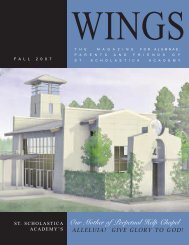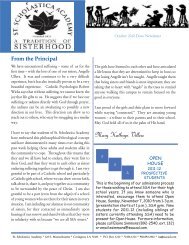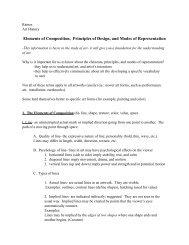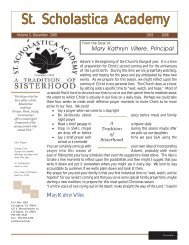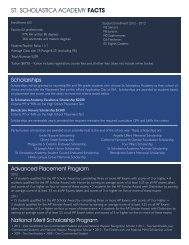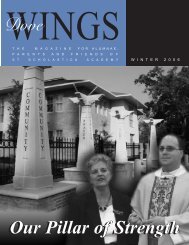Wings Fall 09 - St. Scholastica Academy
Wings Fall 09 - St. Scholastica Academy
Wings Fall 09 - St. Scholastica Academy
Create successful ePaper yourself
Turn your PDF publications into a flip-book with our unique Google optimized e-Paper software.
Iconography<br />
The chapel contains several works of art that are designated as “icons.”<br />
In Greek, “icon” means “image.” Whereas in Western Christianity,<br />
sculpture in conjunction with painting has been employed for liturgical<br />
artistic expression, iconography is used throughout the Eastern<br />
Christian world as the sole liturgical art form. An icon is much more<br />
than a simple representation of events or persons of the past. An icon<br />
makes present that which it depicts. Icons are, therefore, sacramental,<br />
not simply works of art, much less decoration. <strong>St</strong>ylistically, icons differ<br />
from traditional Western art in substantial ways. Perhaps most<br />
noticeably, icons are “flat.” The bodies of the holy subjects depicted have<br />
exaggerated features; typically almond-shaped eyes, enlarged ears, long<br />
thin noses, and small mouths. Through such rendering of the human<br />
form, iconographers attempt to indicate that the sanctified enjoy a new<br />
existence. The use of techniques to create a sense of depth perspective<br />
is shunned in iconography. Similarly, the frontality of the figures is<br />
striking, even confrontational in a passive sort of way. There are no<br />
shadows in icons. The image itself is the source of light. In short, icons<br />
are not realistic but distort reality to present new possibilities. In<br />
addition, icons are notably restrained and balanced yet multifaceted in<br />
symbolic meaning. In the end, icons are able to invite contemplation.<br />
As a final note on the subject, it must be mentioned that tradition<br />
refers to the rendering of an icon not as “painting” but as “writing.” An<br />
icon is understood to be the illumination of the Word of God. As a<br />
“word,” therefore, it is written.<br />
Crucifix<br />
As with the Te Decet Laus of the frieze, the importance of Trinitarian<br />
theology to Christianity is reflected in the crucifix that hangs above the<br />
altar. In addition to a Trinitarian interpretation of the crucifix, a more<br />
Christocentric understanding is also available. This depiction of the<br />
Crucified Savior of the world presents the fullness of the mystery of<br />
the Christian faith in the person of Jesus the Christ.<br />
The upper section of the cross represents God the Father. The Manus<br />
Dei (hand of God) represents the Father, who blesses his Son with<br />
whom He is well pleased. God is hidden by clouds and darkness. The<br />
eight-pointed stars represent his divinity. He “dwells in unapproachable<br />
light, whom no man has ever seen or can see.” (1 Timothy 6:16)<br />
The middle section of the cross shows God the Son, incarnate in the<br />
person of Jesus. Here Jesus is affixed to the wood of the cross, but does<br />
not hang or slump in death. In his humanity he has died. One sees the<br />
wounds of his hands, feet and side, wounds that will forever bear<br />
witness to his suffering. In his divinity he is straight, with eyes wide open.<br />
One sees a King and Lord, wearing a crown and reigning. As sure as<br />
Jesus is fully human, a man who suffered and died on a cross, he is also<br />
fully Divine, incorporeal and insensate. He is, therefore, one and the<br />
same inseparable “person” who at one and the same time lived in glory<br />
and died in agony.<br />
In the nimbus or halo of Jesus is a cross signifying redemption. On his<br />
crown are pearls, sapphires and amethysts. On either side of his halo<br />
are the Greek letters IC and XC. These are the first and last letters of<br />
the name, Jesus Christ. It is essential the personages in icons be<br />
identified with their names. The inscription establishes that the<br />
archetype is present in the image. Also, note well that the hand of the<br />
Father, from the heavenly firmament, and that of the Son, from the<br />
earthbound cross, are both poised in a gesture of blessing. This simple<br />
detail indicates that the Father and the Son are in fact One and<br />
coeternal.<br />
In the lower section of the cross The Holy Spirit, in the traditional form<br />
of a dove, proceeds from the Father and the Son to both safeguard and<br />
teach (Jn 16:12). The dove is the symbol of the Third Person of the<br />
Trinity as cited in the Gospel of Luke 3: 21-22 “and when Jesus also had<br />
been baptized and was praying, the heaven was opened, and the Holy<br />
Spirit descended upon him in bodily form, as a dove, and a voice came<br />
from heaven, ‘Thou art my beloved Son; with thee I am well pleased.’ ”<br />
Our Mother of Perpetual Help<br />
As the titular icon, Our Mother of Perpetual Help holds a prominent<br />
yet appropriately demure position in the chapel. Of the many images<br />
depicting the Mother and Child, this one demonstrates quite effectively<br />
the dynamic relationship between the Virgin and the Fruit of her womb<br />
and, therefore, the relationship between the Blessed Mother and those<br />
who follow her Son.<br />
The icon of Our Mother of Perpetual Help is often referred to as an<br />
icon of the Passion. The angels holding the instruments of the Passion<br />
have their hands covered with a protecting veil as a sign of reverence<br />
in handling sacred objects. The Child Jesus is shown with an adult face<br />
and a high brow, indicating his divine mind of infinite intelligence. As<br />
God, he knew that the angelic apparition was prophetic of his future<br />
passion. Yet in his human nature as a small child, frightened by the vision<br />
of two angels showing him the instruments of the Passion, the Christ<br />
Child runs hastily to his Mother for protection, almost losing one of his<br />
tiny sandals. Mary holds him in her arms reassuringly, lovingly. Our Lady<br />
quickly picks him up and clasps him to her bosom. The Child Jesus<br />
clasps his Mother’s right hand with both of his, holding tightly to Our<br />
Lady’s thumb as a reminder to us that, just as on earth he placed<br />
himself entirely in her hands for protection, so now in heaven he has<br />
given into her hands all graces, to distribute to those who ask her.<br />
Our Lady’s face is of unspeakable majesty and calm, and yet her large<br />
eyes, partly closed, express ineffable sorrow and sympathy. Our Lady is<br />
not looking at Jesus, but rather on us, her adopted children, as if to<br />
express compassion for us in our fears and sorrows. How better to<br />
express Our Lady’s plea to us to love her Son.<br />
The icon of Our Mother of Perpetual Help is a traditional Byzantine<br />
type, but modified by the medieval softening of features in Cardiotissa<br />
style, touching the emotion and showing an action story proper to this<br />
art form. Little imagination is required to see how fitting this patroness<br />
is for a school chapel.<br />
Holy Family and Visitation Icons<br />
Two additional icons commissioned for the chapel are equally suited to<br />
the mission of Saint <strong>Scholastica</strong> <strong>Academy</strong>. The Holy Family and The<br />
Visitation both represent the values of family and sisterhood stressed<br />
during the student’s tenure of academic and spiritual formation.<br />
<strong>St</strong>atue of <strong>St</strong>. <strong>Scholastica</strong><br />
Sculpted of cold cast bronze, the statue of <strong>St</strong>. <strong>Scholastica</strong> that stands<br />
just inside the main entrance was originally commissioned by The<br />
Benedictine Sisters at Sacred Heart in Cullman, Alabama. The Sisters<br />
wanted a portrayal of their patron that captured her spirit and joy. The<br />
title of the sculpture is “Release,” as she is releasing her spirit to God.<br />
The model for the sculpture was a ballet dancer who travels the<br />
country performing Christian/Spiritual Dance. The ballerina pose<br />
portrays the image of <strong>Scholastica</strong> releasing the dove in flight just as<br />
Benedict, her brother, witnessed his sister’s soul leaving her body and<br />
entering into heaven in the form of a dove.<br />
D O V E W I N G S 37




